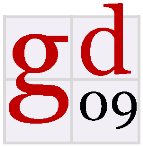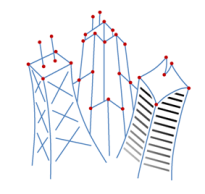16th Graph Drawing Contest
Call for Participation
The 16th Annual Graph Drawing Contest shall be held in conjunction with the 17th International Symposium on Graph Drawing (GD 2009). Except for the challenge competition, which takes place during the conference, all submissions are due by September 18, 2009 (CET).
This year, the contest has two topics: partial graph drawing and the graph drawing challenge.
Partial Graph Drawing
For details, see here.
We provide graphs which are partially laid out. Some of the nodes have specified coordinates, and some of the edges have specified routing points. These nodes and edges are considered fixed. Other nodes and edges have no coordinates and must be laid out. These nodes and edges are free to be moved. All nodes have specified sizes. The task is to find the nicest layout that integrates the free nodes and edges into the layout of the fixed nodes and edges. Note that the fixed nodes and edges should not be moved at all.
The Partial Graph Drawing topic is divided into four categories that will be judged separately. For each category, we provide a data set from a different application domain. The task is to create an aesthetic drawing suitable for the application domain. Manual layout adjustments are allowed, but fully automatic layouts are preferred. For each data set, a separate winner will be determined. The following links provide details and data for each category:
- A Simple Tree
The tree has 56 nodes and 55 directed edges. 16 nodes are fixed. There are no special requirements concerning the edge shapes. For details, see here. - An Org Chart
The org chart has 171 nodes and 170 directed edges. 101 nodes are fixed and 96 edges are fixed. The edges should be laid out in orthogonal fashion. For details, see here. - A Flow Chart
The flow chart has 57 nodes and 72 directed edges. 26 nodes are fixed and 24 edges are fixed. The majority of the edges should point towards the bottom. Orthogonal edges are preferred but not required. For details, see here. - A Mystery City Graph
This is a graph with 391 nodes and 911 undirected edges. The nodes represent cities. The 17 cities of the past Graph Drawing Conferences are fixed, while the remaining cities are free to be moved. There is no requirement concerning edge shapes or layout style. As an additional task, the contestants should determine what this graph depicts. For details, see here.
Partial Graph Drawing Submissions
Submissions for any of these graphs must be received by midnight September 18 (Central European Time) and should include the following information:
- names and email addresses of the contributors,
- a picture illustrating the graph (and optionally, a resulting data file with coordinates for all nodes and edges, in the same format as the input graph), and
- a brief description on how the layout was produced.
Electronic submissions are strongly encouraged. However, if your drawing requires special printing because of size, resolution, or color constraints, you are encouraged to submit via hard-copy. Acceptable electronic formats include PDF and PostScript for images.
All contest submissions should be sent to:
Georg Sander
Wilhelm Flögel Ring 52
60437 Frankfurt, Germany

Graph Drawing Challenge
The challenge will be held during the conference in a format similar to a typical programming contest, where teams are presented with a collection of challenge graphs and have approximately one hour to submit their highest scoring drawings. Following the Graph Drawing Conference tradition, we repeat the same challenge as in year 2008 a second time: minimizing the number of crossings of upward grid drawings of graphs with edge bends. For details, see here.Contest Committee
- Lev Nachmanson, Microsoft
- Christian A. Duncan, Louisiana Tech University
- Carsten Gutwenger, Dortmund University of Technology
- Georg Sander, (Chair), IBM
Questions or comments should be sent to:

